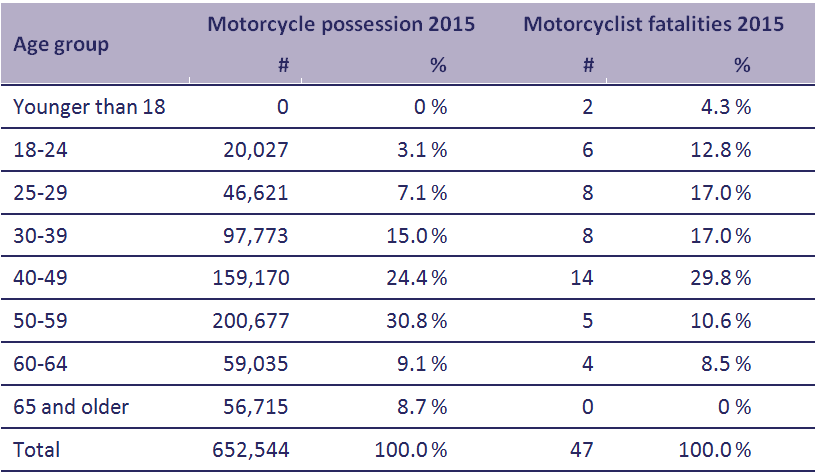Motorcycle crashes are more common for some groups than for others. Below we discuss the groups most frequently involved in motorcycle crashes.
Age
The majority of the motorcyclists killed in 2015 was younger than 50 years (81%). The largest group are the 40-49-year-old motorcyclists (almost 30%). This is also relatively high; in all modes of transport together 'only ' 8% of the road deaths is in the age group 40-49 years old.
We can also compare the number of road deaths among motorcyclists with the possession of motorcycles in the different age groups (Table 1). It is then remarkable that the number of road deaths among the young novice motorcyclists (18-24 year) is disproportionate (12.8%) relative to the motorcycle possession in that age group (3.1%). Also among 25-29-year-old motorcyclists there are relatively many road deaths. The motorcyclists in the age group 50-59 years old, on the other hand, form a very small share (10.6%) relative to the motorcycle possession in this age group (30.8%).
Note that it is not clear what above comparison says about the risks of a certain age group. It may well be that the younger motorcyclists less often possess a motorcycle, but do ride (on someone else’s motorcycle). For reliable statements about risk, we would need to compare the number of crashes and the kilometres travelled per age group. Unfortunately, that information is not (reliably) available.
However, there are indications (from international studies) that young motorcyclists, like young car drivers have a relatively high risk [4]; and also engage in risk behaviour more frequently [5] [6].
 Table 1. Age distribution of motorcycle owners and road deaths among motorcyclists; the numbers and shares in the year 2015.
Table 1. Age distribution of motorcycle owners and road deaths among motorcyclists; the numbers and shares in the year 2015.
Gender
In 2015, 98% of the road deaths among motorcyclists were male (46 men to 1 woman). In the past decade between 90 and 100% of the road deaths and serious road injuries among motorcyclists in the Netherlands were male [7] [8]. The main explanation lies in the fact that men generally ride a motorcycle more and more frequently than women, although the share of female motorcyclists in most OECD countries is on the increase [9].
Type of motorcycle
Studies from the United States and New Zealand indicate that motorcycles with a greater cylinder capacity (from 500 cc) are more frequently involved in (fatal) crashes than motorcycles with a cylinder capacity of 250 cc or less [10] [11]. This may have more to do with the characteristics of the rider who chooses for this motorcycle than with the cylinder content [9]. The researchers [10] [11] found that the riders of the heavier motorcycles more frequently broke the speed limit and more frequently were under the influence of alcohol. In questionnaire studies in the United Kingdom , riders of heavier motorcycles more frequently reported to enjoy higher speeds [12]. This was also found in Taiwan [13]. The American researchers Savolainen & Mannering [14] found that in general riders of heavier motorcycles more often show risk behaviour, including driving without motorcycle helmet and protective clothing. As yet no research into the relationship between the type of motorcycle and the crash involvement of the rider has been done in the Netherlands. Furthermore, 82% of the motorcycles in the Netherlands have a cylinder capacity exceeding 500cc (Figure 2 in the question How much are motorcycles used in the Netherlands?).
